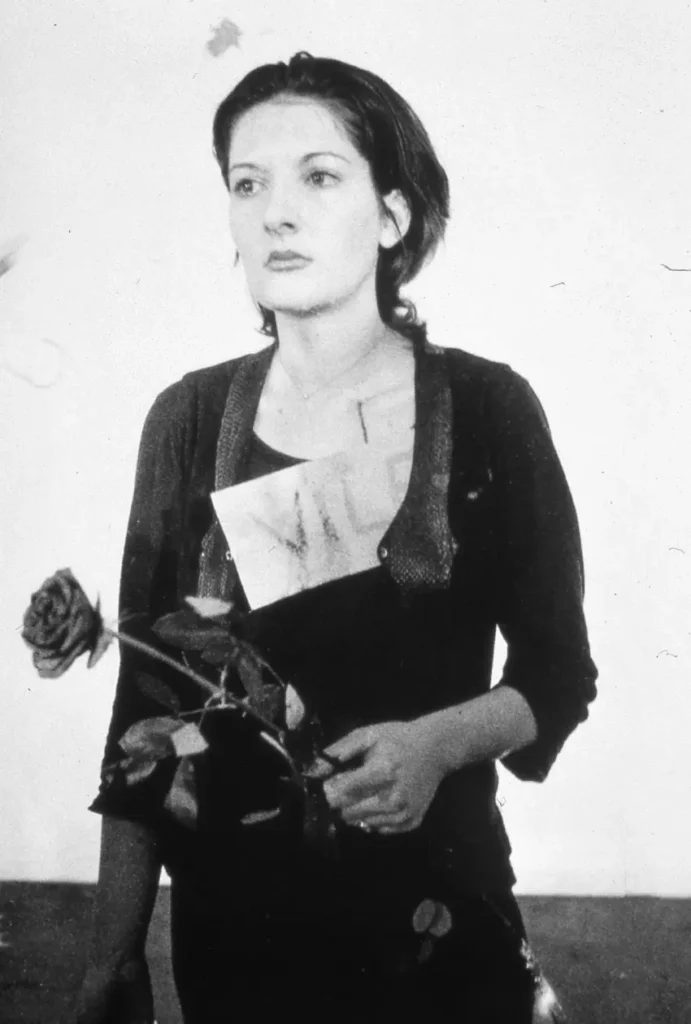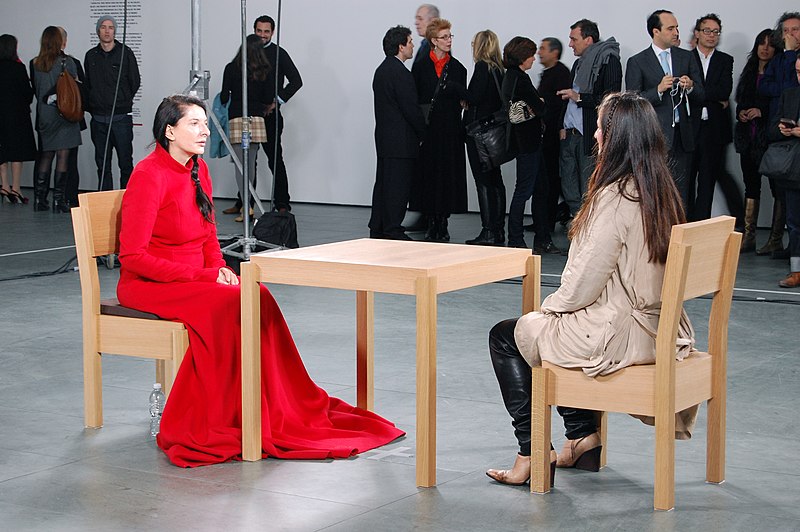Martina Zuzaňáková
Although the art form of performance is perceived rather marginally in our environment, it is quite widespread abroad, mainly thanks to the artist Marina Abramović. The Serbian-born artist is seen as the “mother of performance”, which she owes to both her original artistic expression and her undying energy. What should we know about her?
1. At the beginning of her artistic career she decided to devote herself to painting
Marina Abramović was born on 30. November 1946 in Belgrade. She was introduced to the world of art by her mother Danica Rosić. M. Abramović lived in Belgrade until she was 29 years old. She graduated from the Academy of Fine Arts there, where she first studied painting, but soon turned her attention to working with her own body and space.
2. Her performances are often radical
Marina Abramović’s works are radical both visually and in their message. The artist is known for pushing the boundaries – of her body, her soul and, last but not least, of what people expect from art. In the work Rhythm 0 for example, she stood motionless in a room for six hours, surrounded by seventy-two objects ranging from honey and perfume to a scalpel, scissors, and a single-shot gun. During the performance, visitors were invited to hurt the body of the artist with the objects on display, who motionlessly observed how far one is willing to go if given the opportunity.

Courtesy of the Marina Abramović Archives © Marina Abramović. Photo: Donatelli Sbarra
Source : https://www.royalacademy.org.uk/exhibition/marina-abramovic
3. The Artist Is Present
M. Abramović is the first performer to receive recognition from official critics. She became a definitive artistic celebrity in 2010 when she organized an exhibition at the Museum of Modern Art in New York called The Artist Is Present. The exhibition included a performance of the same name, during which the artist sat on a chair right in the exhibition. Opposite her was a chair on which the audience could sit to look into the artist’s eyes. The work was inspired by the artist’s belief that if the length of the performance is extended, our perception of time changes and we are able to experience deeper emotions. The performance lasted for three months and a total of 850,000 spectators took their turns opposite M. Abramović. The space was constantly filmed by cameras and the seated spectators could not leave. They could only turn inward, and many of them even succumbed to their emotions and wept.

Source%C4%
4. For twelve years she worked with Ulay
Marina Abramović’s work has changed since 1975. The artist left Yugoslavia permanently and formed an artistic duo with the artist and her later life partner Frank Uwe Laysiep, who worked under the pseudonym Ulay. The result of their nearly twelve-year collaboration was works exploring the male and female body, space and problematic marital cohabitation. In the performance Relation in Space (1976), they explored the physical limits of the body as they bumped into each other repeatedly naked. In the case of a happening Breathing In/ Breathing Out (1976) they experimented with the idea of whether it is possible to absorb another person’s life. In the video of this performance, the two artists touch mouths and exchange air with each other until they both fall unconscious. The cooperation between Ulay and M. Abramović ended in 1988, when they broke up. Their journey together concluded with an experiment The Loversduring which they both made their way along the Great Wall. Ulay came from the Gobi Desert. Abramović from the Yellow Sea. Each of them walked 2,500 kilometres to symbolically say goodbye.
5. The work of M. Abramović reflects gender
The artist returns to the theme of gender repeatedly in her work. One of the works in which her reflection is evident is a performance entitled Imponderabilia(1977), during which M. Abramović stood opposite Ulay at the entrance to the museum. Both artists were naked. During the performance, they forced the audience to walk through a narrow gap between their bodies and decide which of the “bodies” to back. In Rest Energy (1980), which again stood out for its radicalism, the artists are pitted against each other. Ulay is holding a bow with a taut bowstring, arrow aimed at M’s heart. Abramović. This joint work is often interpreted in literature in the context of the domination of the male world over the world of women. However, this clear feminist view is corrected by the artist herself, who holds the bow and thus decides about her life.

Courtesy of the Marina Abramović Archives. © Marina Abramović. Photo © Royal Academy of Arts, London / David Parry
Source : https://www.royalacademy.org.uk/exhibition/marina-abramovic
6. She does not forget her childhood or the war in Yugoslavia
In the 1990s, M. Abramović goes back to her childhood, which she herself described as traumatic (her father and mother were both convinced communists), but also to the war in the former Yugoslavia. The atrocities of war and pernicious nationalism became the main subject of the groundbreaking work Balkan Baroque for the 1997 Venice Biennale. During the performance, which attracted great acclaim and for which the artist won the main prize, M. Abramović sat on a pile of fresh animal bones and cleaned them all day. The performance included a video in which the “scientist” M. Abramović stands among portraits of her parents and tells a story about the behaviour of rats.
7. Marina Abramović crosses borders with her works
In exploring the feelings we experience when exposed to unfamiliar emotions, M. Abramović often goes to the very limits of our experience. In a twelve-day performance with scenic elements , The House with the Ocean View (2002), she lived in three open elevated “rooms” at the Sean Kelly Gallery in New York. She didn’t talk and had no privacy. The rooms remained open during the project, allowing the audience to observe the artist as she carried out her daily activities. The performance also contained a moment of injury. The ladders leading to the rooms had knife blades placed in the foot of the ladders so that the artist could not escape from the rooms.

Courtesy of the Marina Abramović Archives © Marina Abramović. Photo: Attilio Maranzano
Source : https://www.royalacademy.org.uk/exhibition/marina-abramovic
8. Founded her own performance school
In 2004 she co-founded the M. Abramović MAI (Marina Abramović Institute), which aims to ensure the survival of performance as an artistic discipline. MAI curates materials on performance, supports performers, and documents various contemporary expressions of the art form. M. Abramović is educating a new generation of artists here. Many of them become actors in the repetition of the artist’s older performances, giving them a new charge.
9. She’s got an incredible shot
The work of M. Abramović is very extensive and the artist does not stop in her efforts to push the boundaries of performance technique even today. Her works often radically confront the very purpose of art and the role of the artist. He believes that performance can bridge the gap between artist and audience and offer a different perception of reality.
10. We can try her way of working for ourselves
M. Abramović has developed her own method that combines performance, spirituality and self-reflection. Its essence is to penetrate deep into the subconscious through exercises and specific rituals to explore our psychological and emotional boundaries. The method is taught in various locations around the world and offers viewers the opportunity to learn about the artist’s work from her own perspective.